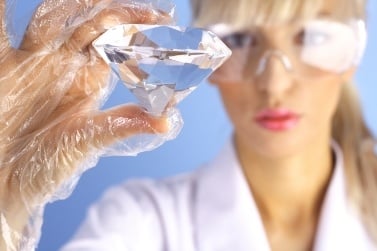
The natural diamond, formed over millions of years is unarguably a rare and valuable manifestation. What about the diamonds that are now being manufactured synthetically? Can these diamonds still be considered precious? Will they replace genuine diamonds in the hearts of our customers? Or are they considered a substandard substitute?
Imitation Diamonds
Imitation diamonds are not a new phenomenon. There have been many attempts over the years to create more affordable, diamond-simulant gems, which purchasers would accept as substitutes for the real thing.
In the 1700s, glass, with the addition of lead, alumina and thallium was formed and cut into rhinestone, which became a common feature of antique jewelry. However, the rhinestone’s durability was its greatest downfall, since it was very soft and its facet edges and face quickly become rounded and scratched. Later, in the early 1900s, the first crystalline artificial diamond simulants were made into durable, synthetic white sapphire and spinel, but these stones failed due to the lack of having the “fire” quality of diamond. The second half of the 1900s introduced the optically "improved" simulant, synthetic rutile, but the success of that synthetic was hindered by its unavoidable yellow tint.
Cubic Zirconia (CZ), formed from zirconium dioxide, has been commercially produced for the jewelry market since 1976. Although popular in its own right, CZ is easy to recognize as a diamond simulant, because it is more brilliant and sparkly than a real diamond and has no tint or inclusions. This unnatural perfection carries with it a certain beauty, but in reality, CZ stones are not a replacement for real diamonds as they simply do not possess the same value or rarity.
Since 1998, manufacturers have also been making simulant diamonds from Moissanite. These are harder than CZ but they tend to look slightly yellow or green. They also often have small inclusions formed during the growing process.
Synthetic Diamonds
The gems known today as “synthetic diamonds” are actually made from carbon and have exactly the same physical and chemical properties as mined diamonds. They were first grown by General Electric in 1954 by using the High Pressure High Temperature (HPHT) method to simulate the heat and pressure that creates natural diamonds in the earth’s crust. This process often produces synthetic diamonds with a yellowish or brownish-yellow color.
The latest method of laboratory-created diamonds is produced by Chemical Vapor Deposition (CVD) which breaks down molecules of gas to accumulate carbon depositions onto a flat diamond seed crystal. Different gasses can create different colored diamonds. A subsequent heat treatment can remove this brown coloration to make the stones colorless and also mask any inclusions, making their identification more difficult.
Do Synthetic Diamonds Have Customer Appeal?
Most leading manufacturers of synthetic diamonds are proud and transparent about the origin of their diamonds. The Pure Grown DiamondsTM brand offers sustainable, eco-friendly, conflict-free and certified diamonds that appeal to the niche market of diamond jewelry customers who care strongly about the environmental, political and human costs of diamond mining.
President and CEO of Pure Grown Diamonds, Lisa Bissell says "Every day, I am greeted with the knowledge that the beautiful diamonds we offer are symbols of not only love and admiration, but of innovative technology, sustainability, and a promise to our future.“
The Impact of Synthetic Diamonds on the Diamond Market
Martin Rapaport, in his 2013 article, SINthetics, said, "New technology is a blessing and so are synthetic diamonds. New ways of doing things and new products are opportunities. They force change and growth, which is a good thing...In the case of synthetics, new technology challenges our values. It’s not just about how flexible, adaptable and forward thinking we are. It’s about how honest we are. Synthetics are G-D’s way of testing our integrity as individuals and as a community. It's the sale of synthetic diamonds as natural that is challenging the integrity of our diamond industry."
Identifying Synthetic Diamonds
Verifying that a diamond is genuine is clearly a concern for diamond dealers and according to the GIA (Gemological Institute of America), recent tests show that the quality of CVD-grown diamonds has improved significantly. This now means that distinguishing synthetic diamonds from natural diamonds requires the use of advanced spectroscopic techniques.
If a customer asks for a certified diamond, the documents produced by responsible diamond laboratories clearly identify synthetic gems as laboratory-grown. Any reliable dealer will always ask to see certification for every stone they buy. This ensures that manufactured diamonds do not enter the market undetected.
Synthetics or Naturals
"Synthetic diamonds are a good thing," Martin Rapaport said further in SINthetics. "They are good for the diamond industry because they will force our trade to be more honest. They will force us to control our supply chain and finally take responsibility for the products we buy and sell. They are good because they are a product category that will increase industry profits."
"And now for the really good news," he continues. "Natural diamonds are hot. While synthetic diamonds can try to get a free ride on the real thing, they will never be the real thing. Make no mistake about it, natural diamonds are better than synthetic diamonds and easier to sell. All we have to do is stop taking our natural diamonds for granted and start setting them against synthetics."
Conclusion
Rapaport concludes, "Consumers subconsciously empower diamonds with symbolic values that they then project onto themselves and each other. “You are special, unique and rare,” communicates the diamond to the woman. The gift of commitment is the expensive diamond because she is worth more than money. Real Love = Real Diamonds™ says it all."
Editor's Note: This post was originally published on November 3, 2015, and has been updated for accuracy.


 RapNet Blog
RapNet Blog





